Sony DCR-VX2200E User Manual
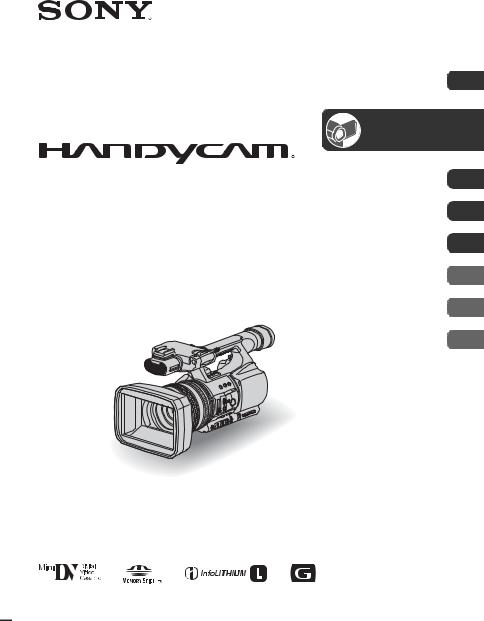
Digital Video Camera Recorder
Operating Guide
DCR-VX2200E
4-161-228-13(1)
Getting Started 10
Recording/ |
21 |
Playback |
|
Using the Menu |
51 |
Dubbing/Editing |
71 |
Using a Computer |
75 |
Troubleshooting |
77 |
Additional Information |
88 |
Quick Reference |
101 |
© 2009 Sony Corporation

Read this first
Before operating the unit, please read this manual thoroughly, and retain it for future reference.
WARNING
To reduce fire or shock hazard, do not expose the unit to rain or moisture.
Excessive sound pressure from earphones and headphones can cause hearing loss.
Do not expose the batteries to excessive heat such as sunshine, fire or the like.
CAUTION
Replace the battery with the specified type only. Otherwise, fire or injury may result.
Battery pack
If the battery pack is mishandled, the battery pack can burst, cause a fire or even chemical burns. Observe the following cautions.
•Do not disassemble.
•Do not crush and do not expose the battery pack to any shock or force such as hammering, dropping or stepping on it.
•Do not short circuit and do not allow metal objects to come into contact with the battery terminals.
•Do not expose to high temperature above 60°C (140°F) such as in direct sunlight or in a car parked in the sun.
•Do not incinerate or dispose of in fire.
•Do not handle damaged or leaking lithium ion batteries.
•Be sure to charge the battery pack using a genuine Sony battery charger or a device that can charge the battery pack.
•Keep the battery pack out of the reach of small children.
•Keep the battery pack dry.
•Replace only with the same or equivalent type recommended by Sony.
•Dispose of used battery packs promptly as described in the instructions.
AC Adaptor
Do not use the AC Adaptor placed in a narrow space, such as between a wall and furniture.
Use the nearby wall outlet (wall socket) when using the AC Adaptor. Disconnect the AC Adaptor from the wall outlet (wall socket) immediately if any malfunction occurs while using your camcorder.
Even if your camcorder is turned off, AC power source (mains) is still supplied to it while connected to the wall outlet (wall socket) via the AC Adaptor.
Notice for customers in the United Kingdom
A moulded plug complying with BS 1363 is fitted to this equipment for your safety and convenience.
Should the fuse in the plug supplied need to be replaced, a fuse of the same rating as the supplied one and approved by ASTA or BSI to BS 1362, (i.e., marked with  or
or  mark) must be used. If the plug supplied with this equipment has a detachable fuse cover, be sure to attach the fuse cover after you change the fuse. Never use the plug without the fuse cover. If you should lose the fuse cover, please contact your nearest Sony service station.
mark) must be used. If the plug supplied with this equipment has a detachable fuse cover, be sure to attach the fuse cover after you change the fuse. Never use the plug without the fuse cover. If you should lose the fuse cover, please contact your nearest Sony service station.
FOR CUSTOMERS IN EUROPE
ATTENTION
The electromagnetic fields at the specific frequencies may influence the picture and sound of this unit.
This product has been tested and found compliant with the limits set out in the EMC Directive for using connection cables shorter than 3 meters (9.8 feet).
2
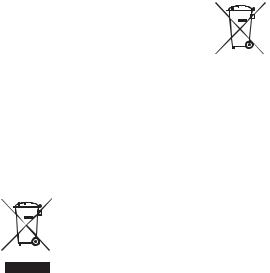
Notice
If static electricity or electromagnetism causes data transfer to discontinue midway (fail), restart the application or disconnect and connect the communication cable (i.LINK, etc.) again.
Notice for the customers in the countries applying EU Directives
The manufacturer of this product is Sony Corporation, 1-7-1 Konan Minato-ku Tokyo, 1080075 Japan. The Authorized Representative for EMC and product safety is Sony Deutschland GmbH, Hedelfinger Strasse 61,70327 Stuttgart, Germany. For any service or guarantee matters please refer to the addresses given in separate service or guarantee documents.
Disposal of Old Electrical & Electronic Equipment (Applicable in the European Union and other European countries with separate collection systems)
This symbol on the product or on its packaging indicates that this product shall not be treated as household waste. Instead it shall be handed over to the applicable collection point for the recycling of electrical and electronic equipment. By ensuring this product is disposed of correctly, you will help prevent potential negative consequences for the environment and human health, which could otherwise be caused by inappropriate waste handling of this product. The recycling of materials will help to conserve natural resources. For more detailed information about recycling of this product, please contact your local Civic Office, your household waste disposal service or the shop where you purchased the product. Applicable Accessory: Remote Commander
Disposal of waste batteries (applicable in the European Union and other European countries with separate collection systems)
This symbol on the battery or on the packaging indicates that the battery provided with this product shall not be treated as household waste.
On certain batteries this symbol might be used in combination with a chemical symbol. The chemical symbols for mercury (Hg) or lead (Pb) are added if the battery contains more than 0.0005% mercury or 0.004% lead.
By ensuring these batteries are disposed of correctly, you will help prevent potentially negative consequences for the environment and human health which could otherwise be caused by inappropriate waste handling of the battery. The recycling of the materials will help to conserve natural resources.
In case of products that for safety, performance or data integrity reasons require a permanent connection with an incorporated battery, this battery should be replaced by qualified service staff only. To ensure that the battery will be treated properly, hand over the product at end-of- life to the applicable collection point for the recycling of electrical and electronic equipment.
For all other batteries, please view the section on how to remove the battery from the product safely. Hand the battery over to the applicable collection point for the recycling of waste batteries.
For more detailed information about recycling of this product or battery, please contact your local Civic Office, your household waste disposal service or the shop where you purchased the product.
Continued , 3

Read this first (Continued)
For the customers in the U.S.A.
If you have any questions about this product, you may call:
Sony Customer Information Center 1-800-222- SONY (7669).
The number below is for the FCC related matters only.
Regulatory Information
Declaration of Conformity
Trade Name: SONY Model No.: DCR-VX2200E
Responsible Party: Sony Electronics Inc.
Address: 16530 Via Esprillo, San Diego, CA 92127 U.S.A.
Telephone No.: 858-942-2230This device complies with Part 15 of the FCC Rules. Operation is subject to the following two conditions: (1) This device may not cause harmful interference, and (2) this device must accept any interference received, including interference that may cause undesired operation.
CAUTION
You are cautioned that any changes or modifications not expressly approved in this manual could void your authority to operate this equipment.
Note
This equipment has been tested and found to comply with the limits for a Class B digital device, pursuant to Part 15 of the FCC Rules. These limits are designed to provide reasonable protection against harmful interference in a residential installation. This equipment generates, uses, and can radiate radio frequency energy and, if not installed and used in accordance with the instructions, may cause harmful interference to radio communications.
However, there is no guarantee that interference will not occur in a particular installation. If this equipment does cause harmful interference to radio or television reception, which can be determined by turning the equipment off and on, the user is encouraged to try to correct the interference by one or more of the following measures:
–Reorient or relocate the receiving antenna.
–Increase the separation between the equipment and receiver.
–Connect the equipment into an outlet on a circuit different from that to which the receiver is connected.
–Consult the dealer or an experienced radio/TV technician for help.
The supplied interface cable must be used with the equipment in order to comply with the limits for a digital device pursuant to Subpart B of Part 15 of FCC Rules.
Notes on use
Types of cassette you can use in your camcorder
You can use mini DV cassettes marked with 

 . Your camcorder does not support the Cassette Memory function (p. 89).
. Your camcorder does not support the Cassette Memory function (p. 89).
Types of “Memory Stick” media you can use in your camcorder
You can use “Memory Stick” media that have the logo shown below (p. 90).
–






 (“Memory Stick Duo” media)
(“Memory Stick Duo” media)
–








 (“Memory Stick PRO Duo” media)
(“Memory Stick PRO Duo” media)
–









 (“Memory Stick PRO-HG Duo” media)
(“Memory Stick PRO-HG Duo” media)
“Memory Stick Duo” media
(This size can be used with your camcorder.)
“Memory Stick” media
(You cannot use with your camcorder.)
•You cannot use any type of memory card except “Memory Stick Duo” media.
4
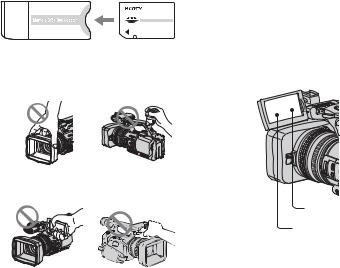
•“Memory Stick PRO Duo” media can be used only with “Memory Stick PRO” media compatible equipment.
•Do not attach a label or the like on a “Memory Stick Duo” media or a “Memory Stick Duo” media Adaptor.
When using a “Memory Stick Duo” media with “Memory Stick” media compatible equipment
Be sure to insert the “Memory Stick Duo” media into the “Memory Stick Duo” media Adaptor.
“Memory Stick Duo” media Adaptor
Using the camcorder
•Do not hold the camcorder by the following part.
way. Squeezing the terminals into your camcorder's jacks may damage them or results in a malfunction of your camcorder.
About menu items, LCD panel, viewfinder, and lens
•A menu item that is grayed out is not available under the current recording or playback conditions.
•The LCD screen and the viewfinder are manufactured using extremely highprecision technology, so over 99.99% of the pixels are operational for effective use. However, there may be some tiny black points and/or bright points (white, red, blue, or green in color) that appear constantly on the LCD screen and the viewfinder. These points are normal results of the manufacturing process and do not affect the recording in any way.
Lens hood |
Viewfinder |
||
with lens cover |
|
|
|
|
|
|
|
|
|
|
|
LCD panel |
Microphone |
b Notes
•The camcorder is not dustproof, dripproof or waterproof.
See “About handling of your camcorder” (p. 93).
•Do not connect cables to your camcorder with their terminals placed the wrong
Black point
White, red, blue or green points
About temperature of your camcorder and battery pack
•Your camcorder has a protective function that disables recording or playback if the temperature of your camcorder or battery pack is beyond the safely operable range. In this case, a message appears on the screen or in the viewfinder (p. 86).
Continued , 5

Read this first (Continued)
Do not expose your camcorder’s viewfinder, lens, or LCD screen to the sun or strong light source for extended periods.
•Intense light sources, especially the sun will converge on the viewfinder or lens and damage the internal parts of your camcorder. Avoid sunlight or other strong light sources when storing your camcorder. Protect this device by always closing the lens cover or by placing it in its bag when not in use.
On recording
•Before starting to record, test the recording function to make sure the picture and sound are recorded without any problems.
•Compensation for the contents of recordings and loss of shooting opportunities cannot be provided, even if recording or playback is not possible due to a malfunction of the camcorder, storage media, etc., or distortion of the picture or sound occurs due to limitations of the camcorder.
•TV color systems differ depending on the countries/regions. To view your recordings on a TV, you need a PAL system-based TV.
•Television programs, films, video tapes, and other materials may be copyrighted. Unauthorized recording of such materials may be contrary to the copyright laws.
•Because of the way that the image device (CMOS sensor) reads out image signals, the subjects passing by the frame rapidly might appear crooked depending on the recording conditions. This phenomenon may be notable in displays having high motion resolution.
Note on the icons used in this manual



 This function that can be used when i.LINK cable is connected.
This function that can be used when i.LINK cable is connected.
 The function that can be assigned to an ASSIGN button.
The function that can be assigned to an ASSIGN button.
About this manual
•The images of the LCD screen and the viewfinder used in this manual for illustration purposes are captured using a digital still camera, and therefore may appear different.
•The on-screen displays in each local language are used for illustrating the operating procedures. Change the screen language before using your camcorder if necessary (p. 18).
•Design and specifications of recording media and other accessories are subject to change without notice.
6

Table of Contents |
|
Read this first ........................................................................................... |
2 |
Getting Started |
|
Step 1: Checking supplied items ............................................................ |
10 |
Step 2: Attaching the lens hood with lens cover ..................................... |
11 |
Step 3: Charging the battery pack .......................................................... |
12 |
Step 4: Turning the power on and holding your camcorder properly ..... |
15 |
Step 5: Adjusting the LCD panel and viewfinder .................................... |
16 |
Step 6: Setting the date and time ........................................................... |
17 |
Changing the language setting .......................................................... |
18 |
Step 7: Inserting a tape or a “Memory Stick Duo” media ....................... |
19 |
Recording/Playback |
|
Recording ............................................................................................... |
21 |
Changing the settings of your camcorder recordings ............................. |
24 |
Adjusting the zoom ............................................................................. |
24 |
Adjusting the focus manually.............................................................. |
25 |
Adjusting the image brightness .......................................................... |
26 |
Adjusting to Natural Color (White balance)......................................... |
29 |
Customizing the picture quality (Picture profile)................................. |
30 |
Adjusting the volume .......................................................................... |
35 |
Assigning the functions to the ASSIGN buttons ..................................... |
37 |
Recording an index signal .................................................................. |
38 |
Reviewing the most recently recorded scenes (Rec review).............. |
38 |
Searching for the last scene of the most recent recording (End search) |
|
............................................................................................................ |
38 |
Using the Shot transition ..................................................................... |
39 |
Playback ................................................................................................. |
42 |
Changing/checking the settings in your camcorder ................................ |
45 |
Changing the screen .......................................................................... |
45 |
Displaying recording data (Data code) .............................................. |
45 |
Displaying the settings in your camcorder (Status check) ................. |
46 |
Checking the remaining battery (Battery Info).................................... |
46 |
Continued , 7

Table of Contents (Continued) |
|
Locating a scene on a tape .................................................................... |
47 |
Searching quickly for a desired scene (Zero set memory) ................. |
47 |
Searching for a scene by date of recording (Date search) ................ |
48 |
Searching for a recording start point (Index search) .......................... |
48 |
Playing the picture on a TV .................................................................... |
49 |
Using the Menu |
|
Using the menu items ........................................................... |
51 |
Menu items ............................................................................................ |
53 |
(CAMERA SET) menu ................................................................... |
55 |
Settings to adjust your camcorder to the recording conditions (GAIN SETUP/ BACK LIGHT/STEADYSHOT, etc.)
(AUDIO SET) menu ....................................................................... |
62 |
Settings for the audio recording (DV AU.MODE/DV AUDIO MIX, etc.)
(DISPLAY SET) menu ..................................................................... |
63 |
Display settings of the display and the viewfinder (MARKER/VF B.LIGHT/DISP OUTPUT, etc.)
(IN/OUT REC) menu ....................................................................... |
66 |
Recording settings, input and output settings (DV REC MODE/ DV WIDE REC/ TV TYPE, etc.)
(MEMORY SET) menu .................................................................... |
67 |
Settings for the “Memory Stick Duo” media (ALL ERASE/FORMAT, etc.) |
|
(OTHERS) menu .............................................................................. |
69 |
Settings while recording on a tape or other basic settings (BEEP, etc.) |
|
Dubbing/Editing |
|
Dubbing to VCR, DVD/HDD device, etc. ............................................... |
71 |
Recording pictures from a VCR ............................................................. |
73 |
Using a Computer |
|
Copying movies on a tape to a computer .............................................. |
75 |
Copying still images to a computer ........................................................ |
76 |
Troubleshooting |
|
Troubleshooting ..................................................................................... |
77 |
Warning indicators and messages ......................................................... |
85 |
8

Additional Information |
|
Using your camcorder abroad ................................................................ |
88 |
Maintenance and precautions ................................................................ |
89 |
Usable cassette tapes ........................................................................ |
89 |
About the “Memory Stick” media ........................................................ |
90 |
About the “InfoLITHIUM” battery pack ............................................... |
91 |
About i.LINK........................................................................................ |
92 |
About handling of your camcorder ..................................................... |
93 |
Specifications ......................................................................................... |
97 |
Quick Reference |
|
Identifying parts and controls ............................................................... |
101 |
Indicators for the LCD screen and viewfinder ...................................... |
106 |
Index ..................................................................................................... |
109 |
9
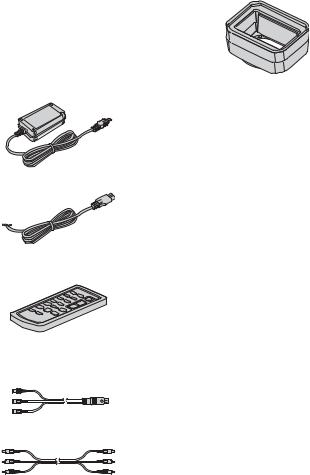
Getting Started
Step 1: Checking supplied items
Make sure that you have following items supplied with your camcorder.
The number in the parentheses indicates the number of that item supplied.
•The cassette tape and “Memory Stick Duo” media are not included. See p. 4, p. 89 and p. 90 for types of cassette tapes and “Memory Stick Duo” media that you can use on your camcorder.
AC Adaptor (1) (p. 12)
Lens hood with lens cover (1) (p. 11)
This lens hood is pre-mounted.
Operating Guide (This manual) (1)
Power cord (mains lead) (1) (p. 12)
Wireless Remote Commander (1) (p. 47, 105)
A button-type lithium battery is already installed.
A/V connecting cable (1) (p. 49, 71)
Video audio cable (1) (p. 49, 71)
10
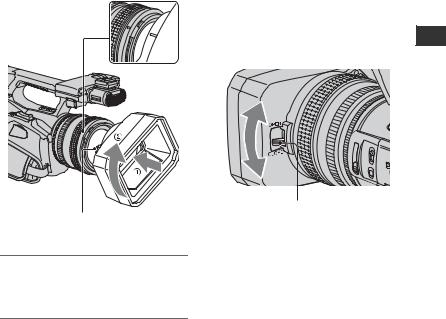
Step 2: Attaching the lens hood with lens cover
To open or close the shutter of the
Lens hood with lens cover
Move the lens cover lever to OPEN to open the lens cover, and move the lever to CLOSE to close the lens cover.
Lens cover lever
PUSH (lens hood release) button
Align the marks on the lens hood to those on the camcorder, and turn the lens hood in the direction of the arrow 2.
To remove the Lens hood with lens cover
Turn the lens hood in the opposite direction to the arrow 2 in the illustration while pressing the PUSH (lens hood release) button.
z Tips
•If you attach or remove a 72mm (2 7/8 in.) PL filter or MC protector, remove the lens hood with lens cover.
Started Getting
11
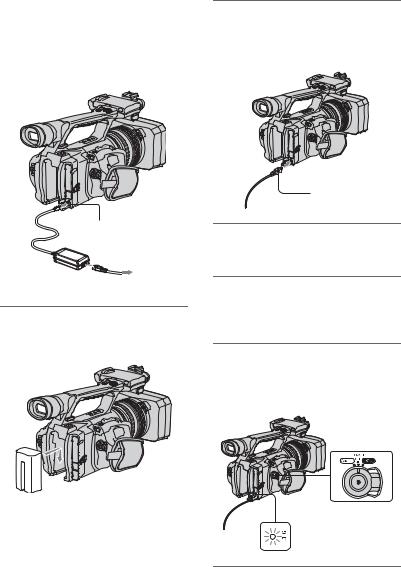
Step 3: Charging the battery pack
You can charge the “InfoLITHIUM” battery pack (L series) with the supplied AC Adaptor.
b Notes
•You cannot use batteries other than the “InfoLITHIUM” battery pack (L series) (p. 91).
DC plug
DC IN jack
To the wall outlet (wall socket)
AC Adaptor
Power cord (mains lead)
1 Press the battery pack against the back of your camcorder and slide it down.
2 With the B mark on the DC plug facing outwards, connect the DC plug to the DC IN jack on your camcorder.
B mark
3 Connect the power cord (mains lead) to the AC Adaptor.
4 Connect the power cord (mains lead) to the wall outlet (wall socket).
5 Set the POWER switch to OFF (CHG).
The CHG lamp lights up and charging starts.
12
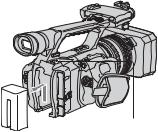
After charging the battery
The CHG lamp turns off when the battery is fully charged. Disconnect the AC Adaptor from the DC IN jack.
z Tips
•You can check the remaining battery life with the battery info function (p. 46)
To remove the battery pack
Set the POWER switch to OFF (CHG). Push the BATT RELEASE (battery release) button and remove the battery pack.
BATT RELEASE (battery release) button
To store the battery pack
If the battery pack will not be used for a while, run down the battery and store it. See page 92 for details on storage of the battery pack.
Charging time
Approximate time (min.) required when you fully charge a fully discharged battery pack.
Battery pack |
Charging time |
NP-F570 |
260 |
|
|
NP-F770 |
370 |
|
|
NP-F970 |
520 |
|
|
Recording time |
|
|
|
|
||
Approximate time (min.) available when |
|
|||||
you use a fully charged battery pack. |
|
|||||
|
||||||
b Notes |
|
|
|
|
||
|
|
|
Getting |
|||
• You cannot use the NP-F330 battery pack with |
||||||
|
||||||
this camcorder. |
|
|
|
|
||
|
|
|
|
Started |
||
|
|
time |
time* |
|
||
|
|
Continuous |
Typical |
|
|
|
Battery pack |
recording |
recording |
|
|
||
|
|
|
|
|
||
NP-F570 |
155 |
75 |
|
|
||
|
|
160 |
80 |
|
|
|
|
|
|
|
|
||
NP-F770 |
315 |
155 |
|
|
||
|
|
330 |
165 |
|
|
|
|
|
|
|
|
||
NP-F970 |
475 |
235 |
|
|
||
|
|
490 |
245 |
|
|
|
|
|
|
|
|||
Top: |
When the LCD backlight turns on. |
|
||||
Bottom: Recording time when recording with the viewfinder while the LCD panel is closed.
*Typical recording time shows the time when you repeat recording start/stop, turning the power on/off and zooming.
Playing time
Approximate time (min.) available when you use a fully charged battery pack.
Battery pack |
LCD panel |
LCD panel |
|
opened* |
closed |
||
|
|||
NP-F570 |
225 |
235 |
|
|
|
|
|
NP-F770 |
460 |
480 |
|
|
|
|
|
NP-F970 |
690 |
725 |
|
|
|
|
* When the LCD backlight turns on.
On the battery pack
•Before changing the battery pack, set the POWER switch to OFF (CHG).
•The CHG lamp flashes during charging, or Battery Info (p. 46) will not be correctly displayed under the following conditions.
–The battery pack is not attached correctly.
–The battery pack is damaged.
–The battery pack is worn-out (For Battery Info only).
Continued , 13

Step 3: Charging the battery pack (Continued)
–The battery pack is too cold.
Replace the battery pack, or remove it and put it in a warm place.
–The battery pack is too hot.
Replace the battery pack, or remove it and put it in a cool place.
•The power will not be supplied from the battery as long as the AC Adaptor is connected to the DC IN jack of your camcorder, even when the power cord (mains lead) is disconnected from the wall outlet (wall socket).
On the charging/recording/playback time
•Times measured with the camcorder at 25 °C (77 °F). 10 °C to 30 °C (50 °F to 86 °F) is recommended.
•The recording and playback time will be shorter when you use your camcorder in low temperatures.
•The recording and playback time will be shorter depending on the conditions under which you use your camcorder.
Using an outside power source
You can use the AC Adaptor to obtain AC. While you are using the AC Adaptor, the battery pack will not lose its charge even when it is attached to your camcorder.
Connect your camcorder as shown in Step3:Charging the battery pack (p. 12).
•Do not short-circuit the DC plug of the AC Adaptor or battery terminal with any metallic objects. This may cause a malfunction.
14

Step 4: Turning the power on and holding your camcorder properly
To record or play back, set the POWER switch to the respective direction.
When you use your camcorder for the first time, the [CLOCK SET] screen appears (p. 17).
POWER switch
1 While pressing the green button, slide the POWER switch.
Press and hold the green button when you slide the  POWER switch from OFF (CHG).
POWER switch from OFF (CHG).
CAMERA: To record pictures.
VCR: To play or edit pictures.
b Notes
•The current date and time appear on the LCD screen for a few seconds when you turn on your camcorder once you set the date and time ([CLOCK SET], p. 17).
2 Hold the camcorder properly.
Started Getting
3 Ensure a good grip, then fasten the grip belt.
To turn off the power
Slide the POWER switch to OFF (CHG).
b Notes
•If warning messages appear on the screen, follow the instructions (p. 86).
15
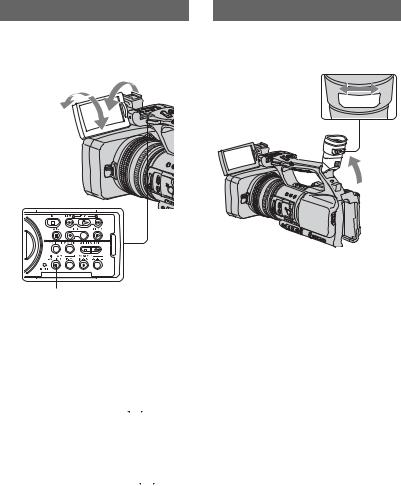
Step 5: Adjusting the LCD panel and viewfinder
The LCD panel
Open the LCD panel 180 degrees (1), then rotate it to the best angle to record or play back (2).
1Open 180 degrees.
290 degrees (max.)
2180 degrees (max.)
DISPLAY/BATT INFO button
z Tips
•You can see your mirror image on the LCD screen by setting the LCD panel facing you. The image will be recorded in a normal image.
To turn off the LCD backlight to make the battery last longer
Press and hold the DISPLAY/BATT INFO button for a few seconds until 

 appears. This setting is practical when you use your camcorder in bright conditions or when you want to save battery power. The recorded picture will not be affected by the setting. To turn on the LCD backlight, press the DISPLAY/BATT INFO button.
appears. This setting is practical when you use your camcorder in bright conditions or when you want to save battery power. The recorded picture will not be affected by the setting. To turn on the LCD backlight, press the DISPLAY/BATT INFO button. 

 disappears.
disappears.
z Tips
•You can adjust the brightness of the LCD screen from [LCD BRIGHT] (p. 65).
The viewfinder
You can view pictures using the viewfinder to save the battery, or when the picture on the LCD screen is not clear.
Viewfinder lens adjustment lever
Move it until the picture  becomes clear.
becomes clear. 
b Notes
•You may see primary colors shimmering in the viewfinder when you move your eye line. This is not a malfunction. The shimmering colors will not be recorded on the recording media.
z Tips
•You can adjust the brightness of the viewfinder backlight from [VF B.LIGHT] (p. 65).
•To display images both on the LCD display and in the viewfinder, set [VF POWERMODE] to [ON] (p. 65).
16
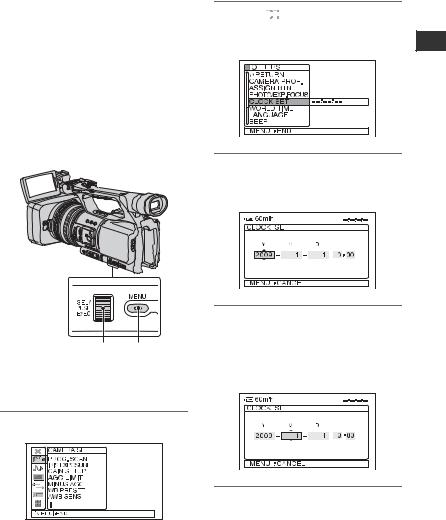
Step 6: Setting the date and time
Set the date and time when using this camcorder for the first time. If you do not set the date and time, [CLOCK SET] screen appears every time you turn on your camcorder or change the POWER switch positions.
z Tips
•If you do not use your camcorder for about 3 months, the built-in rechargeable battery gets discharged and the date and time settings may be cleared from the memory. In that case, charge the rechargeable battery and then set the date and time again (p. 95).
SEL/PUSH EXEC dial MENU button
Skip to step 4 when you set the clock for the first time.
1 Press the MENU button.
2 Select 
 (OTHERS) by turning the SEL/PUSH EXEC dial, then press the dial.
(OTHERS) by turning the SEL/PUSH EXEC dial, then press the dial.
3 Select [CLOCK SET] by turning the SEL/PUSH EXEC dial, then press the dial.
4 Set [Y] (year) by turning the SEL/ PUSH EXEC dial, then press the dial.
You can set any year up to the year 2079.
5 Set [M] (month), [D] (day), hour and minute, then press the dial.
The clock starts.
Started Getting
Continued , 17

Step 6: Setting the date and time (Continued)
z Tips
•The date and time are automatically recorded on the tape, and can be displayed during playback (DATA CODE button, p. 45).
Changing the language setting
You can change the on-screen displays to show messages in a specified language. Press the MENU button to select the

 (OTHERS) with the SEL/PUSH EXEC dial.
(OTHERS) with the SEL/PUSH EXEC dial.
Select the screen language in [LANGUAGE] (p. 70).
18
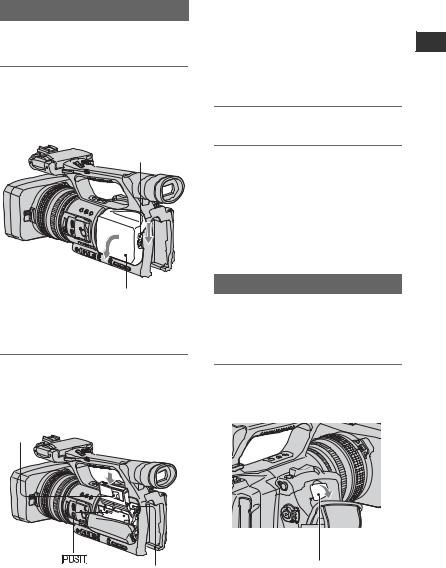
Step 7: Inserting a tape or a “Memory Stick Duo” media
Cassette tape
You can use mini DV 

 cassettes only (p. 89).
cassettes only (p. 89).
1 Slide and hold the  OPEN/ EJECT lever in the direction of the arrow and open the lid.
OPEN/ EJECT lever in the direction of the arrow and open the lid.
 OPEN/EJECT lever
OPEN/EJECT lever
Lid
The cassette compartment automatically comes out.
The cassette compartment automatically slides back in.
b Notes
•Do not push the portion marked {DO NOT PUSH} while the cassette
compartment is sliding in. Doing so may cause a malfunction.
3 Close the lid.
z Tips
•The recordable time varies depending on [DV REC MODE] (p. 66).
To eject the cassette
Open the lid following the same procedure as described in step 1 and remove the cassette.
“Memory Stick Duo” media
You can use only a “Memory Stick Duo” media marked with 






 ,
,









 or
or










 (p. 90).
(p. 90).
Started Getting
2 Insert a cassette with its window facing outwards, then press
 .
.
|
Push the center of |
|
Window |
the back of the |
|
cassette lightly. |
||
|
Cassette compartment
1 Open the “Memory Stick Duo” media slot cover in the direction of the arrow.
“Memory Stick Duo” media slot cover
Continued , 19
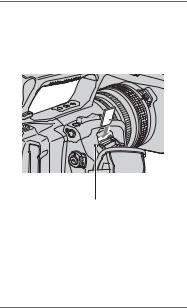
Step 7: Inserting a tape or a “Memory Stick Duo” media (Continued)
2 Insert the “Memory Stick Duo” media into the “Memory Stick Duo” media slot in the right direction until it clicks.
Access lamp
b Notes
•If you insert the “Memory Stick Duo” media into the slot in the wrong direction, the “Memory Stick Duo” media, the “Memory Stick Duo” media slot, or image data may be damaged.
To eject a “Memory Stick Duo” media
Lightly push the “Memory Stick Duo” media once.
b Notes
•When the access lamp is lit or flashing, your camcorder is reading/writing data. Do not shake or knock your camcorder, turn the power off, eject the “Memory Stick Duo” media, or remove the battery pack. Otherwise, image data may be damaged.
•When inserting or ejecting the “Memory Stick Duo” media, be careful with the “Memory Stick Duo” media from popping out and dropping.
20

Recording/Playback
Recording
REC START/STOP button B |
Recording lamp |
PHOTO/EXPANDED |
Lens hood with lens cover |
FOCUS button |
|
Recording lamp |
|
POWER switch |
REC START/STOP button A
Your camcorder records movies on tape and still images on “Memory Stick Duo” media. Do the following steps to record movies.
1 Open the shutter of the lens hood.
Recording/Playback
2 Slide the POWER switch to CAMERA while pressing the green button.
Slide the POWER  switch while pressing
switch while pressing
the green button.
Continued , 21

Recording (Continued)
3 Press the REC START/STOP button A (or B).
[STBY] t [REC]
The recording lamp lights up during recording.
To stop the movie recording, press the REC START/STOP button again.
z Tips
•You can switch the aspect ratio to 16:9 ([DV WIDE REC] p. 66).
•You can change the screen display during recording (p. 45).
•Indicators displayed on the screen during recording are shown on page 106.
•The recording lamp can be set to stay off ([REC LAMP] p. 70).
•You cannot record movies on a “Memory Stick Duo” media.
•For low angle recording, the REC START/STOP button on the handle is convenient. Release the HOLD lever to enable the REC START/STOP button. It might be helpful if you set the LCD panel face up or close it after turning it face down, or lift the viewfinder up during the low angle recording.
22

To capture still images
Press the PHOTO/EXPANDED FOCUS button or the PHOTO button on the Remote Commander.
A still image will be recorded on the “Memory Stick Duo” media. 






 disappears when the recording is completed.
disappears when the recording is completed.
You can capture still images during movie recording.
b Notes
•Specifications are for Sony “Memory Stick Duo” media. The actual number of recordable pictures can vary depending on the recording environment and the type of “Memory Stick Duo” media.
•You cannot store a still image under the following conditions:
–When the shutter speed is slower than 1/50
–While using the fader
–While using [SMTH SLW REC]
–While using shot transition
–When [COLOR BAR] is set to [ON]
z Tips
•When you take a still image while not recording a movie, you will hear the shutter click.
•Image sizes of still images are as follows:
–Recording at an aspect ratio of 16:9: 1.2M
–Recording at an aspect ratio of 4:3: 0.9M
–Playing back at an aspect ratio of 16:9: 0.2M
–Playing back at an aspect ratio of 4:3: VGA
•Indicators displayed on the screen during shooting are shown on page 106.
•You can set the PHOTO/EXPANDED FOCUS button to start the expanded focus function as you press the button ([PHOTO/EXP.FOCUS] p. 69).
•The unique pixel array of Sony's ClearVid CMOS sensor and image processing system (Enhanced Imaging Processor) allows for still image resolution equivalent to the sizes described.
Capacity of the “Memory Stick Duo” media (MB) and the number of recordable pictures
|
1.2M |
0.9M |
VGA |
0.2M |
|
|
|
1440 × |
1080 × |
640 × |
640 × |
|
|
|
810 |
810 |
480 |
360 |
|
|
|
1.2M |
|
|
|
|
|
512MB |
770 |
1000 |
2900 |
3650 |
|
|
|
|
|
|
|
|
|
1GB |
1550 |
2100 |
6000 |
7500 |
|
Recording/Playback |
|
|
|
|
|
|
|
2GB |
3150 |
4300 |
12000 |
15000 |
|
|
|
|
|||||
|
|
|
|
|
|
|
4GB |
6300 |
8500 |
23500 |
29500 |
|
|
|
|
|
|
|
|
|
8GB |
12500 |
17000 |
48000 |
60000 |
|
|
|
|
|
|
|
|
|
16GB |
25500 |
34500 |
97500 |
122000 |
|
|
|
|
|
|
|
|
|
32GB |
50500 |
68500 |
192500 |
240500 |
|
|
|
|
|
|
|
|
|
To store still images captured from movies on a tape on “Memory Stick Duo” media
You can capture an image in a movie and record it on a “Memory Stick Duo” media as a still image. Be sure to insert a recorded tape and a “Memory Stick Duo” media in your camcorder.
1 Set the POWER switch to VCR.
2Press the N(play) button to search for the scene you want to save as a still image. Press the PHOTO/EXPANDED FOCUS button or the PHOTO button on your Remote Commander at the scene.
b Notes
•The recorded date and time on the tape and the stored date and time on the “Memory Stick Duo” media are both saved on the “Memory Stick Duo” media. When you view the still images, only the recorded date and time on the tape will be displayed on the screen (Data code, p. 45).
•Camera data stored on the tape will not be copied to the “Memory Stick Duo” media.
•You cannot store a still image during using your camcorder with [PB ZOOM] set to [ON] (p. 70).
23
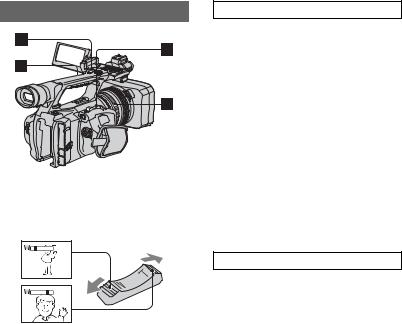
Changing the settings of your camcorder recordings
Adjusting the zoom
Move the power zoom lever C slightly for a slower zoom. Move it further for a faster zoom.
Wide view: (Wide angle)
Using the handle zoom
1Set the handle zoom switch B to VAR or FIX.
z Tips
•When you set the handle zoom switch B to VAR, you can zoom in or out at variable speed.
•When you set the handle zoom switch B to FIX, you can zoom in or out at fixed speed set in [HANDLE ZOOM] (p. 58).
2Press the handle zoom lever A to zoom in or out.
b Notes
•You cannot use the handle zoom lever A when the handle zoom switch B is set to OFF.
•You cannot change the zoom speed of the zoom lever C with the handle zoom switch B.
Close view: (Telephoto)
z Tips
•The minimum distance required between your camcorder and the subject for focus is about 1 cm (about 13/32 in.) for wide angle and about 80 cm (about 2 5/8 feet) for telephoto.
•The focus may not be adjusted at certain zoom positions if the subject is within 80 cm (about 2 5/8 feet) from your camcorder.
•Be sure to keep your finger on the power zoom lever C. If you move your finger off the power zoom lever C, the operation sound of the power zoom lever C may also be recorded.
Using the zoom ring
You can zoom at the desired speed by turning the zoom ring D. Fine adjustment is also possible.
b Notes
•Turn the zoom ring D at a moderate speed. If you turn it too fast, the zoom speed may lag behind the zoom ring rotation speed, or the operation sound of the zoom may also be recorded.
24
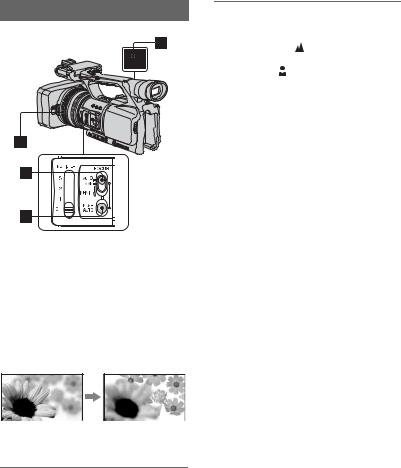
Adjusting the focus manually
You can adjust the focus manually for different recording conditions.
Use this function in the following cases.
–To record a subject behind a window covered with raindrops.
–To record horizontal stripes.
–To record a subject with little contrast between the subject and its background.
–When you want to focus on a subject in the background.
– To record a stationary subject using a tripod.
1 During recording or standby, set the FOCUS switch B to MAN.
9 appears.
2 Rotate the focus ring A and |
|
|||
adjust the focus. |
|
|||
9 changes to |
when the focus |
|
||
cannot be adjusted any farther. 9 |
|
|||
changes to |
when the focus cannot be |
|
||
|
||||
adjusted any closer. |
|
|||
z Tips |
|
|
|
|
For focusing manually |
Recording/Playback |
|||
• It is easier to focus on the subject when you use |
||||
|
||||
the zoom function. Move the power zoom lever |
|
|||
towards T (telephoto) to adjust the focus, and |
|
|||
then, towards W (wide angle) to adjust the zoom |
|
|||
for recording. |
|
|
|
|
• When you want to record a close-up image of a |
|
|||
subject, move the power zoom lever towards W |
|
|||
(wide angle) to fully magnify the image, then |
|
|||
adjust the focus. |
|
|
|
|
|
|
|
||
To restore automatic adjustment |
|
|||
Set the FOCUS switch B to AUTO. |
|
|||
9 disappears and the automatic focus |
|
|||
adjustment is restored. |
|
|||
|
|
|
||
Using automatic focus temporarily |
|
|
||
(Push auto focus) |
|
|
||
|
|
|
||
Record the subject while pressing and |
|
|||
holding the PUSH AUTO button C. |
|
|||
If you release the button, the setting returns |
|
|||
to manual focusing. |
|
|||
Use this function to shift the focus on one |
|
|||
subject to another. The scenes will shift |
|
|||
smoothly. |
|
|
|
|
z Tips
•The focal distance information (for when it is dark and hard to adjust the focus) appears for about 3 seconds in the following cases. (It will not be displayed correctly if you are using a conversion lens (optional)).
–When you set the FOCUS switch to MAN and 9 appears on the screen
–When you rotate the focus ring while 9 is displayed on the screen.
Continued , 25
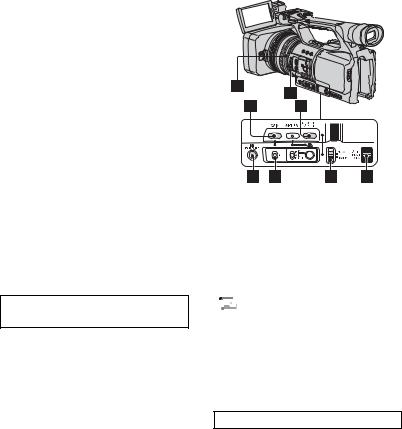
Changing the settings of your camcorder recordings (Continued)
Using the expanded focus |
|
Adjusting the image brightness |
(Expanded focus) |
|
|
|
|
|
|
|
|
Assign [EXP.FOCUS] to the PHOTO/ EXPANDED FOCUS button D beforehand ([PHOTO/EXP.FOCUS], p. 69).
During standby, press the PHOTO/ EXPANDED FOCUS button D. [EXPANDED FOCUS] appears and the center of the screen is magnified by about 2.0 times. It will be easier to confirm the focus setting during manual focusing. The screen returns to the original size when you push the button again.
b Notes
•The image returns to the original size when you
press the REC START/STOP button or the PHOTO/EXPANDED FOCUS button D.
z Tips
•You can select a type of an expanded image displayed during the expanded focus ([EXP.FOCUS TYPE] p. 64).
•You can assign [EXP.FOCUS] to any one of the ASSIGN buttons (p. 37).
Focusing on a distant subject (Focus infinity)
Slide the focus switch to INFINITY and hold it there.
 appears.
appears.
To return to manual focus mode, release the FOCUS switch.
Use this function to record a distant subject when the focus is automatically set on a close subject.
b Notes
•This function is only available during the manual focus.
You can adjust the image brightness by adjusting the iris, the gain or the shutter speed or by reducing the light volume with the ND filter B. Also, when [EXPOSURE] is assigned to the iris ring, you can adjust the iris, gain and shutter speed with the iris ring A. You can assign [IRIS] or [EXPOSURE] to the iris ring A from [IRIS/EXPOSURE] of the



 (CAMERA SET) menu (p. 55). The default setting is [IRIS].
(CAMERA SET) menu (p. 55). The default setting is [IRIS].
b Notes
•You cannot use the back light function and the spotlight function if at least two of iris, gain and shutter speed are adjusted manually.
•[AE SHIFT] is not effective while you adjust the iris, gain and shutter speed all manually.
Adjusting the iris
You can manually adjust the iris to control the volume of the light entering the lens. By adjusting the iris, you can change or close the aperture of the lens, which is expressed as an F value between F1.6 and F11. The volume of the light increases the more that you open the aperture (decreasing F value). The volume of the light decreases the more that you close the aperture (increasing F
26

value). The current F value appears on the screen.
1Select [IRIS] from 

 (CAMERA SET) menu t [IRIS/EXPOSURE] t [RING ASSIGN] (p. 55).
(CAMERA SET) menu t [IRIS/EXPOSURE] t [RING ASSIGN] (p. 55).
2During recording or standby, set the AUTO/MANUAL switch F to MANUAL.
3When the iris is automatically adjusted, press the IRIS/EXPOSURE button H.
 next to the iris value disappears
next to the iris value disappears
(p. 64), or the iris value appears on the screen.
4Adjust the iris by turning the iris ring
A.
z Tips
•The F value becomes close to F3.4 as the zoom position changes from W to T even when you open the aperture by setting the F value lower than F3.4, such as F1.6.
•The range of focus, an important effect of the aperture, is called the depth of field. The depth of field gets shallower as the aperture is opened, and deeper as the aperture is closed. Use the aperture creatively to obtain the desired effect in your photography.
•This is handy for making the background blurred or sharp on the screen.
To restore automatic adjustment
Press the IRIS/EXPOSURE button H, or set the AUTO/MANUAL switch F to AUTO.
The iris value disappears, or  appears next to the iris value.
appears next to the iris value.
b Notes
•When you set the AUTO/MANUAL switch F to AUTO, other manually adjusted items (gain, shutter speed, white balance) also become automatic.
Adjusting the exposure
When [IRIS/EXPOSURE] is set to [EXPOSURE], you can adjust the image brightness by adjusting the iris, gain and shutter speed with the iris ring. You can
also manually preset one or two of these parameters and adjust the remaining parameter(s) with the iris ring.
1Select [EXPOSURE] from 

 (CAMERA SET) menu t [IRIS/ EXPOSURE] t [RING ASSIGN] (p. 55).
(CAMERA SET) menu t [IRIS/ EXPOSURE] t [RING ASSIGN] (p. 55).
2During recording or standby, set the AUTO/MANUAL switch F to MANUAL.
3When [EXPOSURE] is automatically
adjusted, press the IRIS/EXPOSURE button H.
 appears on the screen next to the automatically adjusted items (iris, gain
appears on the screen next to the automatically adjusted items (iris, gain
and shutter speed), indicating that you can adjust them with the iris ring A. Manually adjusted items do not change even when you turn the iris ring.
When  is not displayed, do the following operation.
is not displayed, do the following operation.  appears next to the items, indicating that you can adjust them with the iris ring A.
appears next to the items, indicating that you can adjust them with the iris ring A.
–Gain
Press the GAIN button C.
–Shutter speed
Press the SHUTTER SPEED button D twice. When the shutter speed is not locked, press the button once.
4Adjust the image brightness by turning the iris ring A.
To restore automatic adjustment
Press the IRIS/EXPOSURE button H, or set the AUTO/MANUAL switch F to AUTO.
The values next to which  is displayed disappear, or
is displayed disappear, or  appears next to those values.
appears next to those values.
b Notes
•When you set the AUTO/MANUAL switch F to AUTO, all manually adjusted items (iris, gain, shutter speed and white balance) also become automatic.
Recording/Playback
Continued , 27

Changing the settings of your camcorder recordings (Continued)
z Tips
•When you press the GAIN button C while  is displayed on the screen next to the gain value,
is displayed on the screen next to the gain value,
 disappears and you can adjust the gain manually. When you press the GAIN button C
disappears and you can adjust the gain manually. When you press the GAIN button C
again,  appears and you can adjust the gain with the iris ring. See step 3 in “Adjusting the gain” on page 28 for details on how to adjust the gain.
appears and you can adjust the gain with the iris ring. See step 3 in “Adjusting the gain” on page 28 for details on how to adjust the gain.
•When you press the SHUTTER SPEED button
D while  is displayed on the screen next to the shutter speed value,
is displayed on the screen next to the shutter speed value,  disappears and you can adjust the shutter speed manually. When you press the SHUTTER SPEED button D
disappears and you can adjust the shutter speed manually. When you press the SHUTTER SPEED button D
again,  appears and you can adjust the shutter speed with the iris ring. See steps 3 to 4 in “Adjusting the shutter speed” on page 28 for details on how to adjust the shutter speed.
appears and you can adjust the shutter speed with the iris ring. See steps 3 to 4 in “Adjusting the shutter speed” on page 28 for details on how to adjust the shutter speed.
Adjusting the gain
You can adjust the gain manually when you do not want to use the AGC (automatic gain control).
1Set the AUTO/MANUAL switch F to MANUAL during recording or standby.
2When the gain is automatically adjusted, press the GAIN button C.
The gain value appear on the screen, or  next to the gain value disappears.
next to the gain value disappears.
3Set the gain switch G to H, M or L. The gain value set for the selected gain switch position appears on the screen. You can set the gain value for each gain
switch position from [GAIN SETUP] of
the 

 (CAMERA SET) menu (p. 55).
(CAMERA SET) menu (p. 55).
z Tips
•When you record a movie with the gain set to [-6dB] and play it back with the data code, the gain value is displayed as [---].
b Notes
•When you set the AUTO/MANUAL switch F to AUTO, other manually adjusted items (iris, shutter speed, white balance) also become automatic.
Adjusting the shutter speed
You can manually adjust and fix the shutter speed. You can make a moving subject look still or emphasize the movement of a moving subject by adjusting the shutter speed.
1During recording or standby, set the AUTO/MANUAL switch F to MANUAL.
2Press the SHUTTER SPEED button D until the shutter speed value is highlighted.
3Change the shutter speed displayed on
the screen by turning the SEL/PUSH EXEC dial E.
You can set a shutter speed between 1/3 second and 1/10000 second.
The selected shutter speed appears on the screen. For example, if you select 1/100 second, [100] appears. The larger the number that appears on the screen, the faster the shutter speed.
4Press the SEL/PUSH EXEC dial E to lock the shutter speed.
To readjust the shutter speed, do steps 2 to 4.
z Tips
•It is difficult to focus automatically at a lower shutter speed. Manual focusing with your camcorder attached to a tripod is recommended.
•The picture may flicker or change colors under fluorescent lamps, sodium lamps, or mercury lamps.
To adjust the gain automatically
Press the GAIN button C, or set the AUTO/MANUAL switch F to AUTO. The gain value disappears, or  appears next to the gain value.
appears next to the gain value.
28
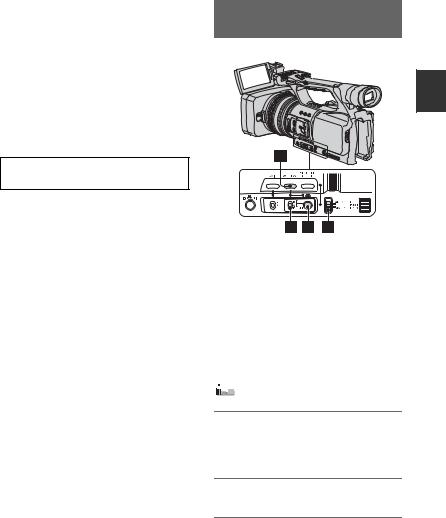
To adjust the shutter speed automatically
Press the SHUTTER SPEED button D twice, or set the AUTO/MANUAL switch F to AUTO.
The shutter speed value disappears, or  appears next to the shutter speed value.
appears next to the shutter speed value.
b Notes
•When you set the AUTO/MANUAL switch F to AUTO, other manually adjusted items (iris, gain, white balance) also become automatic.
Adjusting the volume of light (ND filter)
You can record the subject clearly by using the ND filter B when the recording environment is too bright.
There are 3 levels of ND filter setting. ND filter 1 reduces the volume of light to about 1/4, ND filter 2 to about 1/16 and ND filter 3 to about 1/64.
If 
 flashes during the iris automatic adjustment, set the ND filter to 1. If
flashes during the iris automatic adjustment, set the ND filter to 1. If 

 flashes during the iris automatic adjustment, set the ND filter to 2. If
flashes during the iris automatic adjustment, set the ND filter to 2. If 

 flashes during the iris automatic adjustment, set the ND filter to 3.
flashes during the iris automatic adjustment, set the ND filter to 3.
The ND filter indicator will stop flashing and remain on the screen.
If 

 flashes, set the ND filter to OFF.
flashes, set the ND filter to OFF. 

 will disappear from the screen.
will disappear from the screen.
b Notes
•If you move the ND filters B during recording, the picture and sound may be distorted.
•When adjusting the iris manually, the ND filter indicator does not flash even if the light volume should be adjusted with the ND filter.
z Tips
•While recording a bright subject, diffraction may occur if you close the aperture further down, resulting in a fuzzy focus (this is a
common phenomenon with video cameras). The ND filter B suppresses this phenomenon and gives better recording results.
Adjusting to Natural Color (White balance)
Recording/Playback
You can adjust and fix the white balance according to the lighting conditions of recording environment. You can store white balance values in memory A ( A) and memory B (
A) and memory B ( B), respectively. Unless a white balance is readjusted, values will remain even after the power has been turned off.
B), respectively. Unless a white balance is readjusted, values will remain even after the power has been turned off.
When you select PRESET, either [OUTDOOR] or [INDOOR] is selected, according to which one you previously set with [WB PRESET] in the




 (CAMERA SET) menu.
(CAMERA SET) menu.
1 During recording or standby, set the AUTO/MANUAL switch D to
MANUAL.
2 Press the WHT BAL button A.
3 Set the white balance memory switch B to any one of
PRESET/A/B.
Continued , 29
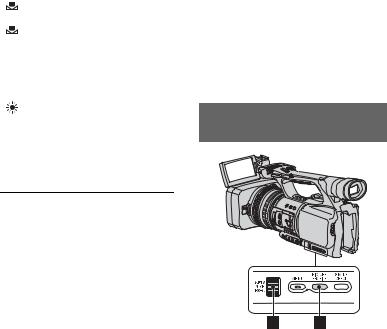
Changing the settings of your camcorder recordings (Continued)
Indicator |
Shooting conditions |
|
A |
• White balance values |
|
(Memory A) |
adjusted for light |
|
B |
sources can be stored |
|
in memory A and |
||
(Memory B) |
||
memory B. Follow the |
||
|
||
|
steps in “To save the |
|
|
adjusted white balance |
|
|
value in memory A or |
|
|
B” (p. 30). |
|
|
|
|
|
• Recording neon signs |
|
Outdoor |
or fireworks |
|
• Recording sunset/ |
||
([OUTDOOR]) |
||
|
sunrise, just after |
|
|
sunset or just before |
|
|
sunrise |
•Under daylight color fluorescent lamps
n• Under the lighting
Indoor |
conditions that change |
|
([INDOOR]) |
in many ways, such as |
|
a party hall |
||
|
||
|
• Under strong light |
|
|
such as in a |
|
|
photography studio |
|
|
• Under sodium lamps |
|
|
or mercury lamps |
|
|
|
To save the adjusted white balance value in memory A or B
1Set the white balance memory switch to
A ( A) or B (
A) or B ( B) in step 3 of “Adjusting to natural color (White balance).”
B) in step 3 of “Adjusting to natural color (White balance).”
2Capture a white subject, such as white paper, full-screen in the same lighting condition as the one in which the subject is.
3Press  (one push) button C.
(one push) button C.
 A or
A or  B starts flashing rapidly. It will stay on when the white balance adjustment is completed and the
B starts flashing rapidly. It will stay on when the white balance adjustment is completed and the
adjusted value is stored in  A or
A or
 B.
B.
To adjust the white balance automatically
Press the WHT BAL button A or set the AUTO/MANUAL switch D to AUTO.
b Notes
•When you set the AUTO/MANUAL switch D to AUTO, other manual adjustments (iris, gain, shutter speed) also become automatic.
Customizing the picture quality (Picture profile)
You can customize the picture quality by adjusting picture profile items such as [COLOR LEVEL] and [SHARPNESS]. Connect your camcorder to a TV or monitor, and adjust the picture quality while observing the picture on the TV or monitor screen.
Picture quality settings for different recording conditions are stored in [PP1] through [PP6] as default settings.
30
